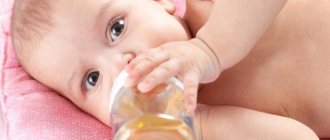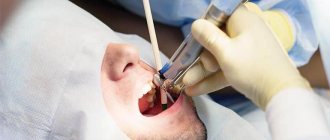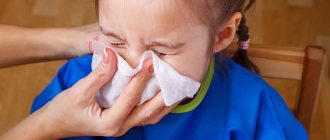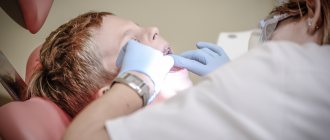The formation of baby teeth is a stressful situation for a baby, to which his body usually reacts with an increase in body temperature. Of course, this happens not only because of teething. It will be useful for many parents to know what to do when their baby suddenly has a fever.
What is the timing of teething?
Milk teeth erupt at a certain period in a child’s life. Not all parents know how long this lasts. It is important to determine the exact timing in order to understand what causes hyperthermia. The following main periods are distinguished:
- 5-6 months - first the lower, then the upper incisors appear, usually they erupt one by one;
- 9-11 months - upper lateral incisors;
- 12-13 months - lower lateral incisors;
- 12-16 months - chewing teeth, molars;
- 16 months - upper and lower canines;
- 18-24 months - second molars;
- 7-10 years - indigenous elements;
- 14 years and older - wisdom teeth.
Absolutely all teeth appear by 2-2.5 years. If a child's body temperature rises in the first 2 months after birth or after 3 years, this is not due to teething. With hyperthermia in the period from 4 months to 2.5 years, the indicators usually do not exceed low-grade fever.
The temperature does not rise above 38.5 degrees and lasts for a short time.
As a result of eruption, 16 teeth should appear. If parents have counted this number, this means the process has stopped. When the body temperature rises with all these teeth present, eruption is impossible. Then they look for the cause in an infectious or viral disease or other pathologies.
Every parent worries about their child and many begin to panic when he or she develops symptoms of some disease. Parents are not doctors, but they should know the general signs of disease in order to identify it from the very beginning of development and take treatment and preventive measures. Read more in the article: “Rubella in children - information for parents.”
Child's body temperature when replacing baby teeth with permanent ones
During the period of loss of baby teeth and the appearance of permanent teeth, the child’s body temperature remains normal. Only some children's body temperature rises when permanent molars begin to form. The reason for this is the size and shape of the molars.
Typically, children's first permanent teeth begin to form at the age of six. If at this time the child’s temperature rises, then there is a possibility of gingivitis. This disease is characterized by inflammation of the mucous membrane of the gums and requires treatment.
Signs of teething in a baby
Teething occurs normally in a child. That is, it is a physiological process. If you examine the baby’s oral cavity, you can see the following main signs:
- strong secretion of saliva that flows from the child’s mouth (this is a protective reaction of the body aimed at eliminating pathogenic microorganisms in the oral cavity);
- gums swollen, hyperemic;
- refusal to eat;
- chewing foreign objects, for example, TV remote control, toys;
- disorder of stool formation accompanied by diarrhea;
- Teeth may be visible on the gums, indicating their approach.
No other foreign formations should appear in the mouth. The child becomes whiny and irritable. He constantly demands the breast or bottle for food. This calms him down. Strong crying occurs throughout the day, but intensifies at night.
If the temperature is associated with teeth, immediately after teething the low-grade fever will end. This distinguishes it from a cold. The indicator will return to normal, the child will stop crying often and being restless. The condition is often observed during the eruption of fangs. But in some children it can appear on all teeth.
The substance codeine is obtained semi-synthetically from opium. When compared to other substances in terms of action, codeine is similar to morphine. It has a pronounced therapeutic effect, but if the recommended dosage is significantly exceeded, it becomes a drug. Read more in the article: “Cough tablets with codeine.”
Mechanism of caries development
Caries, according to experts, is the most common disease in the world, occurring in more than 90% of the world's population. Despite this, many people have only a superficial knowledge of tooth decay. Therefore, questions often arise about possible symptoms of the disease, in particular, whether the temperature can rise with caries. To understand, let’s first consider what the carious process is. Essentially, this is the slow destruction of a tooth under the influence of various factors, the main ones of which are oral bacteria and carbohydrate foods.
Microbes with cariogenic effects feed on sugars and convert them into acids, which cause destruction of dental tissue. If a person does not remove plaque (colonies of bacteria on teeth) well and at the same time eats a lot of carbohydrates, he creates favorable conditions for the development of caries.
This pathological process in most cases develops gradually. Acids first attack the enamel, then penetrate the dentin, damaging the dental tissues deeper and deeper. If caries is not cured in time and the deep spread of pathology is not stopped, sooner or later caries will develop into pulpitis or periodontitis. These are severe conditions in which the tissues of the pulp (neurovascular bundle) and periodontal tissue (they surround the tooth) become inflamed.
Teething symptoms in older children
By the age of 7-8 years, the second stage of teeth appearance begins. The milky elements fall out and are replaced by radical structures. This process is tolerated by children much easier than in infancy. There is practically no pain syndrome, since there is already a hole in the gum and it is not damaged. But the following discomfort signs may develop:
- aching sensation in the mouth;
- severe itching in the gums;
- insomnia or taking a long time to fall asleep at night;
- lack of concentration, absent-mindedness;
- swelling of the cheek;
- in rare cases, a slight rise in temperature to 37-37.5 degrees.
Negative signs in the child quickly disappear. But it is important to ensure that infection does not penetrate into the hole where the baby tooth used to be. If a child has a tendency to pathology, it is recommended to rinse the mouth with furatsilin, chamomile, and other herbal antiseptics. Most products not only have disinfectant properties, but also relieve inflammation.
Typically, the filling of the oral cavity with radical elements occurs closer to 10 years. In some children the process may occur delayed. But most cases end quickly and painlessly.
What is the maximum temperature possible during this period?
How much the temperature rises when a baby’s teeth appear depends only on his individual characteristics. On average, this figure is 37.5-37.7 degrees. Sometimes this figure can reach 38 - this is also an acceptable value. It is important to take regular measurements, since infants do not regulate heat exchange well and as inflammation progresses, the temperature can increase very quickly.
A higher temperature (39-40 degrees) may indicate complications, the development of a respiratory tract infection and requires immediate medical attention.
Signs of pathologies in the mouth
More often in infants, increased salivation and low-grade fever mean teething. This is not always true. If the following symptoms appear, it is recommended to look for the disease:
- coating on the tongue (gastritis, colitis);
- white growths on the gums (stomatitis);
- bad breath (pathologies of the gastrointestinal tract, tonsils, adenoids);
- small or large wounds caused by mechanical damage, infection;
- bleeding of soft tissues;
- severe swelling of the cheek caused by the accumulation of exudate in the inner part of the tissue (for example, with flux).
Symptoms develop due to bacterial or fungal infection. Children at this age often chew on foreign objects and toys. If they have sharp edges, there is a high risk of mechanical damage to the gums.
If you are unsure of the cause of the child’s negative condition, it is better to consult a pediatrician.
It is important to identify the infectious process in a timely manner so that bacterial or fungal infection does not spread throughout the internal tissues. This is fraught not only with damage to the mucous membrane, but also with the development of purulent formations. Pathologies are more difficult to treat and are more difficult for the child to tolerate.
Signs of wisdom teeth erupting
Teething does not always happen in children. When it comes to wisdom teeth, the age is determined from 14 years and older. Usually the process is completed by 30-35 years. The molars are large in size and slowly move up the soft tissues. This causes the following negative symptoms in patients:
- increase in body temperature up to 38 degrees;
- an increase in body temperature above 38 degrees, if the eruption of wisdom teeth is accompanied by suppuration of the soft tissues due to the proliferation of infection;
- inability to chew food because the tissues are swollen;
- extensive swelling of the cheek;
- the lesion hurts at any time of the day, but the discomfort intensifies after eating food due to prolonged chewing;
- runny nose caused by the accumulation of immune cells in the nasopharynx during inflammation in the oral cavity.
Most wisdom teeth erupt very slowly. Then the inflammation develops less, the swelling is minimal. If the process occurs at a rapid speed, acute pain occurs. Wisdom teeth are dangerous not only because of their eruption, but also because of the tendency of this area to form gum pockets filled with purulent exudate. This happens when food gets under the gum.
In rare cases, molar eruption may be pathological. For example, the molar is not turned up, but to the side. It damages the adjacent tooth as it grows. It is recommended to remove such elements in a timely manner. They are detected using radiography.
What causes body temperature to rise during the formation of baby teeth?
There is a misconception that a child’s elevated body temperature during the eruption of baby teeth is not normal and therefore measures should be taken to lower it to a normal level. In fact, this is not so. The fact is that at the site of tooth eruption, the body’s immune defense decreases. Harmful bacteria enter the disturbed gum and cause an inflammatory process, which is always accompanied by an increase in body temperature. It should be understood that elevated temperatures have a detrimental effect on harmful microorganisms. Of course, this does not mean that excessively high temperatures during teething are normal.
Parents of the baby should not worry if, during the formation of baby teeth, the baby’s body temperature does not exceed 38 degrees.
In one-year-old babies, the process of tooth formation is much more complicated. It is after the first year of life that a child’s canines and molars begin to form. These teeth erupt much more slowly and, accordingly, increased body temperature can persist for a long time. Their long formation is explained by the uneven shape of the molars and their size. Sometimes it lasts several weeks.
The same situation occurs during the eruption of eye teeth. Their roots are located much deeper than the rest of the baby's teeth. Therefore, the growing eye tooth has to travel a longer path to the gum surface. All this time, the child experiences discomfort, and his body responds to it with an increase in body temperature.
In essence, the emerging baby teeth tear the soft tissue of the gums, and this cannot be painless. In this place, the immune defense is weakened due to injury. During the formation of molars, children often develop a fever. This happens when the impact of harmful microorganisms becomes too powerful, that is, an infectious infection has occurred. In this case, the body temperature rises to 38 degrees, and sometimes above.
Diagnosis confirmation
Parents will not always be able to understand why their child’s temperature has risen. Then it is recommended to consult a pediatrician to confirm the diagnosis. At an early stage, pathologies are easier to eliminate. Hyperthermia does not always occur against the background of teething.
When it comes to small children whose baby teeth are just developing, X-rays are not taken.
Excessive radiation negatively affects health. You just need to get examined by a pediatrician or dentist. If the temperature persists for more than 3 days, other negative symptoms occur, a smear is taken to determine the presence or absence of infection. When the doctor cannot accurately determine the cause, the condition continues to worsen, an x-ray is prescribed.
For older children, the range of diagnostic procedures has been expanded. For their age, acute pain when the root elements occur is not typical. The following diagnostics are recommended:
- examination by a pediatrician or dentist;
- radiography of the jaws;
- bacterial culture of a nasopharyngeal swab;
- opening of swollen gums if internal suppuration is suspected.
After completing the diagnosis, the correct treatment is prescribed. Thanks to the examination, the cause is accurately understood without giving the child unnecessary medications. If the discomfort and low-grade fever persist after completion of therapy, laboratory and instrumental examinations are repeated.
What to do when the temperature rises?
If a child develops hyperthermia due to teething, no specific treatment is required. The condition passes quickly, but many children have a hard time bearing it. If only a slight low-grade fever develops, antipyretics are not used.
In rare cases, the temperature may rise above 38 degrees. Only then do doctors allow the use of antipyretic drugs. The following medications are used:
- Nurofen is a non-steroidal anti-inflammatory drug based on ibuprofen, which simultaneously reduces body temperature, eliminates inflammation and pain;
- Paracetamol is an antipyretic with much fewer side effects than NSAIDs.
Most medications that eliminate teething hyperthermia contain ibuprofen or paracetamol. They may differ in name, but the active substance remains the same. It is important to choose the right shape. For children under 3 years of age, a syrup form is recommended. After this age, tablets are used. Injections are not used during teething.
Antipyretics are used in a short course. Excessively long use leads to adverse reactions. This is especially true for NSAIDs, they negatively affect the gastrointestinal tract.
How long does the temperature last
Gum inflammation in young children is a common dental disease. After all, children's mucous tissues are unprotected and delicate, and local protective forces are not yet fully operational. If the temperature jumps 39-40 degrees, consult a doctor immediately. Sometimes, at the time of the appearance of incisors, canines and molars, high body temperatures can last for several days.
If the high temperature returns to normal within three days, this is normal. But, there is prolonged hyperthermia. In this case, safety will be ensured by a pediatrician. He will be able to determine whether there is another reason for this phenomenon. When teething, the temperature can last a long time and go down badly. Therefore, you should not risk the child’s health; you should call a doctor in time. He will determine whether there is an infection, whether there is persistent swelling with hemorrhage on the gum. Perhaps such a clinical picture develops with the active birth of two masticatory organs at once.
Parental care and love works wonders! Involve your little one in the game more often. Take him in your arms. An upright position will relieve pain as it will reduce blood flow to the gums. Be patient! Do not let your baby scream or cry for a long time, this exhausts his nervous system.
How to help with teething?
Measures of treatment and assistance with teething depend on the age of the patient. If it is a baby, the condition is difficult to tolerate. Many drugs are not available for this group of patients. For adult children, completely different therapy is prescribed. All methods are listed in the table.
| Method of therapy | Young children | Older children or adults |
| Painkillers | Anesthetic gels applied to the gums. For example, Kalgel, Kamistad. They act locally, so the risk of side effects is reduced | Topical gel applied to the gums. If the pain is unbearable, take a non-opioid analgesic. NSAIDs relieve pain, fever, inflammation (Ibuprofen) |
| Herbal decoctions | The method is rarely used; it is impossible to predict allergies. Use chamomile or calendula lotions. They have a disinfecting, anti-inflammatory effect | Rinse your mouth with a decoction of chamomile, calendula, celandine, and oak bark. |
| Rinse with antiseptics | Not applicable | Furacilin, Chlorhexidine. Destroy pathogenic microorganisms in the oral cavity, preventing infection of the socket |
| Doctor's help | Not used, teeth erupt on their own | If eruption is difficult, use a scalpel incision in the gums. The method is used for purulent infection |
If a runny nose, diarrhea, or hyperthermia persists after the tooth appears, look for another cause. Conditions require different treatments. For example, using antibiotics.
Sore throat after dental treatment
It happens that after treatment, a patient not only has a toothache and fever, but also a sore throat. What are the reasons?
Firstly, a sore throat could be present before treatment and intensify after visiting the dentist, in a qualitative response of the body.
Secondly, it is rare, but it still happens that the doctor touches the mucous membrane of the throat with an instrument.
And finally, thirdly, pain after tooth extraction or treatment can radiate to the throat.
All of the above can cause a sore throat after visiting the doctor, but in rare cases, pain may occur several days after taking it.
Why is teething accompanied by hyperthermia?
When a tooth erupts, an inflammatory reaction occurs at the site of gum damage. Immune cells accumulate in this area to protect this part of the mouth from bacteria and fungi. This forms swelling. Chewing becomes difficult and appetite disappears.
Severe pain, the influence of the immune system, and constant lack of sleep in the child lead to an increase in body temperature. It can last 1-3 days. But this is where it always ends and goes back to normal. This distinguishes it from pathologies that form in the oral cavity.
Low-grade fever (value 37-37.5 degrees) is not eliminated in any condition. It means that the body is fighting against some damaging factor, therefore it activates all its forces. Even if the condition is caused by a viral or bacterial infection, antipyretics are not recommended. The same applies to the appearance of new dental elements.
If hyperthermia rises above 38 degrees, it is important to determine the true cause of the condition. When it comes to teeth, use only an antipyretic. If a bacterial infection is present, local or systemic antibiotics are additionally prescribed.
Other symptoms accompanying fever
During teething, there may be other symptoms in addition to fever. Swelling of the gums can spread from the oral cavity to the nasal mucosa, thereby causing a slight runny nose and the discharge of a slight transparent mucous secretion. This symptom is more pronounced when the upper teeth erupt.
The appearance of baby teeth is often accompanied by excessive salivation, especially when the lower teeth erupt. This also causes a slight loosening of the stool - the stool becomes a little softer than usual.










